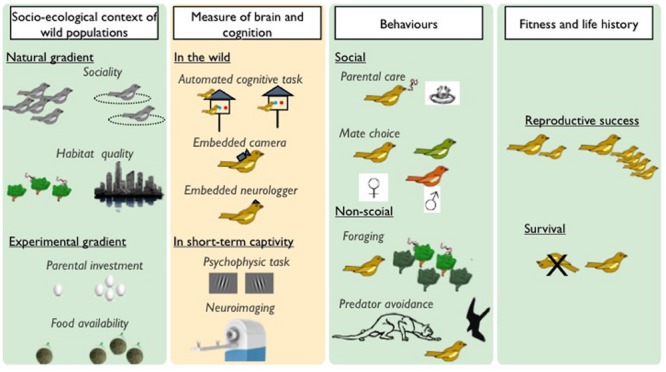FIGURE 2.

How to study brain and cognition selection? Ideal studies looking at contemporary selection on neurocognitive traits should integrate socio-ecological conditions (left), neurocognitive traits (middle left), ecologically relevant behaviors (middle right), and fitness (right) variables. Such an approach seeks to truly merge behavioral and evolutionary (green background) and cognitive neuroscience (yellow background) methods. As examples: Socio-ecological contexts of selection could correspond to natural gradients in sociality (i.e., Population density, gregariousness), habitat quality (i.e., level of fragmentation, urbanization) and/or distribution of resources (i.e., harshness of the environment). Experimental manipulations of ecological factors, such as variation in food supplementation or reintroduction in a novel environment, are of particular interest to isolate ecological causes of selection. Cognitive abilities can be measured in the wild using automated foraging tasks. Such methods rely on individual identification usually mediated by passive integrated transponders (PIT) tags. However, some cognitive functions are difficult to measure in the wild and one may want to have a better control on motivational state and environmental parameters. Short-term periods of captivity seem appropriate in such a framework and potentially enable us to use current psychophysics protocols and equipment developed in comparative cognition labs. Development of embedded cameras or microphones has the potential to reveal spontaneous cognitive capabilities like tool use, social cognition or vocal communication. Likewise, neurologgers or transmitters enable us to measure brain activity (electroencephalogram, single unit activity) in free ranging wild animals. Spatial and whole brain measurement could also be assessed using MRI or PET devices in short term scanning protocol. Ecologically relevant behaviors linked to fitness such as parental care, mate choice, foraging, predator avoidance, should be measured to evaluate interactions between agents of selection and between cognitive abilities that are hypothesized to underlie these behaviors. The fitness benefit is traditionally assessed through evaluation of reproductive success (number of offspring who breed) or a measure of survival. Behavior associated with reproductive success (i.e., mating, number of offspring born, parental care) can also be used as proxies of fitness.
